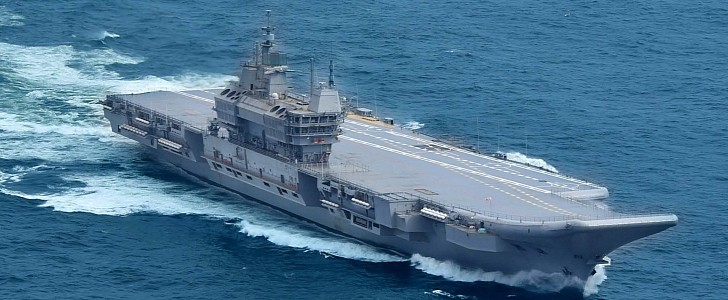India has just stepped up its naval force game. The first aircraft carrier in the country’s history to be made almost entirely with local components and resources has just been commissioned. And its gas turbines come from the same company that provides 95% of the engines for the U.S. Navy fleet.
During the Indo-Pakistani war in 1971, India started operating its first-ever aircraft carrier, the INS (Indian Naval Ship) Vikrant. Half a century later, a game-changing vessel with the same name is ready to start what is expected to be a glorious career.
The new Vikrant, with 76% indigenous content, is taking India to a new level, where only a few nations in the world with IAC (indigenous aircraft carriers) play.
According to the Indian Express, several large industry partners, plus more than 100 smaller companies, helped accomplish this ambitious project that was initiated in 2007.
General Electric (GE) also announced that four of its LM2500 engines are powering this important ship. The four gas turbines add up to 88 MW and enable the Vikrant to cruise at 28 knots (32 mph/52 kph).
They’ll be built by Hindustan Aeronautics Limited (HAL), which has been one of GE’s partners for decades.
The LM2500 gas turbines are used to power the fleet of 40 navies around the world, and the ones for the Indian Navy have been assembled and tested until now at HAL’s facility in Bangalore.
With a length of almost 860 feet (262 meters) and a total of 14 decks, the new Vikrant is able to operate up to 30 aircraft, both fixed-wing and rotary. It claims to sport a high degree of automation when it comes to navigation and system operation, and it integrates an advanced aircraft-operation mode called STOBAR (Short Take-Off but Arrested Landing). This includes a ski-jump for launches and a set of “arrester wires” for onboard recovery.
According to GE, now that Vikrant was launched, the Indian Navy has 18 GE engines in service, with more currently in production.
The new Vikrant, with 76% indigenous content, is taking India to a new level, where only a few nations in the world with IAC (indigenous aircraft carriers) play.
According to the Indian Express, several large industry partners, plus more than 100 smaller companies, helped accomplish this ambitious project that was initiated in 2007.
General Electric (GE) also announced that four of its LM2500 engines are powering this important ship. The four gas turbines add up to 88 MW and enable the Vikrant to cruise at 28 knots (32 mph/52 kph).
They’ll be built by Hindustan Aeronautics Limited (HAL), which has been one of GE’s partners for decades.
The LM2500 gas turbines are used to power the fleet of 40 navies around the world, and the ones for the Indian Navy have been assembled and tested until now at HAL’s facility in Bangalore.
With a length of almost 860 feet (262 meters) and a total of 14 decks, the new Vikrant is able to operate up to 30 aircraft, both fixed-wing and rotary. It claims to sport a high degree of automation when it comes to navigation and system operation, and it integrates an advanced aircraft-operation mode called STOBAR (Short Take-Off but Arrested Landing). This includes a ski-jump for launches and a set of “arrester wires” for onboard recovery.
According to GE, now that Vikrant was launched, the Indian Navy has 18 GE engines in service, with more currently in production.







